LG G5 vs Samsung Galaxy S7: A rebel and a stunner
A rebel and a stunner

Photo quality
Before we start with photo quality, we have to figure out what to do with LG G5's second camera. It only has 8MP resolution and is a fixed-focus unit, so it won't take part of the image quality comparison, but the advantage in field of view it offers is massive - 135° vs. 75°.
How much is that, really? Well, G5's wide camera captures things that are usually found off to your sides. Here's a visual comparison, a simple way of thinking about it is that you cover double the horizontal space than you do with the regular camera.
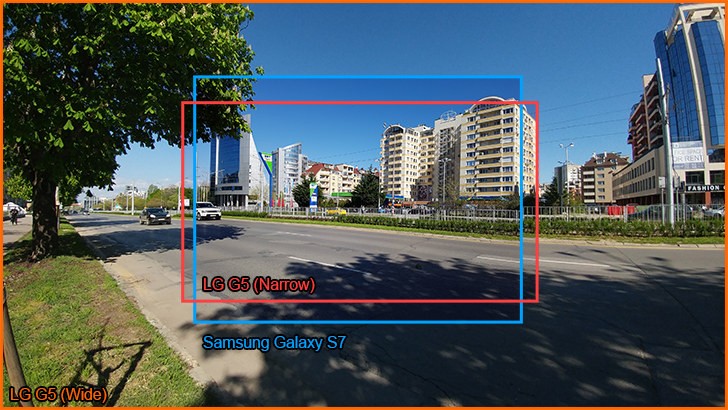



Field of view: LG G5 (Wide) • LG G5 (Narrow) • Samsung Galaxy S7
Both LG G5 cameras are 16:9 while Samsung went back to 4:3. This gives it less horizontal coverage, but more vertical. They have different resolutions too - 16MP for the LG G5, 12MP for the Galaxy S7 - giving the LG an edge in good light.
You will definitely notice some distortion when shooting wide photos with the LG G5, this is unavoidable with a camera this wide. At half the resolution and with a wider FoV, the wide camera can't compete on fine detail. Here's a quick example of what happens when we blow up a wide photo to 16MP.
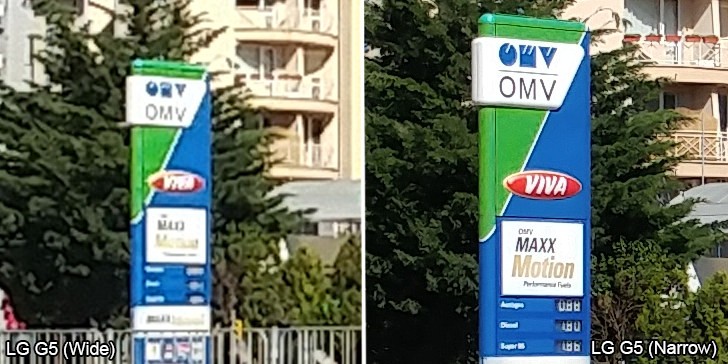
Here's the same scene through the eyes of LG G5's narrow camera and the Samsung Galaxy S7.
Both cameras fill up the histogram from end to end, making the most of their dynamic range (which seems about equal). The Samsung definitely applies a harsher contrast curve. This affects the color rendering too, look at how much lighter the green is.
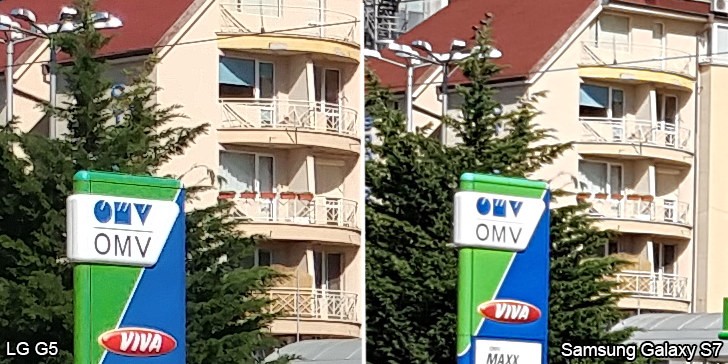


Sample 1: LG G5 • Samsung Galaxy S7
The contrast brings out more detail, which can be seen in the texture of this building. Another part of it is that the Galaxy S7 applies more sharpening, but does a better job of it too - you can see streaks of detail among smudgy patches in the LG G5 while detail is more even in the S7 photo.
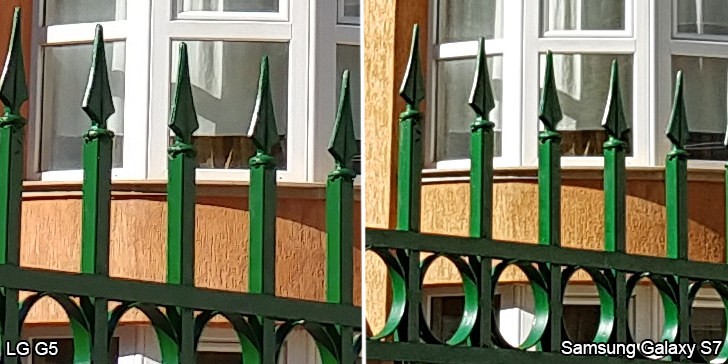


Sample 2: LG G5 • Samsung Galaxy S7
Samsung tends to overdo it though - let's look at some foliage. You can see the patches that the G5 smudged up, the grass and bushes look more natural than the contrasty, oversharpened photo the Galaxy took.
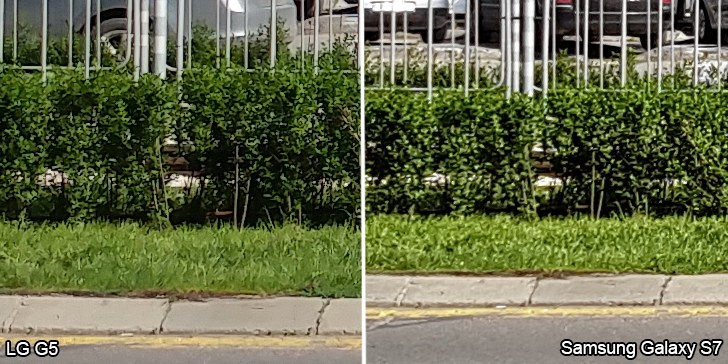


Sample 3: LG G5 • Samsung Galaxy S7
The LG G5 features a Color Spectrum sensor, which should help it pick out the right color balance even in difficult lighting situations. It is more accurate than the Galaxy S7 most of the time. We did notice that some parts of the photos have a slight tint to them, but it was rare.

Samsung was the first to introduce Phase Detection autofocus in mobile phones (with the S5). With PDAF, you get a fixed number of points that detect whether they are in or out of focus and the camera's lens makes the necessary corrections. This works in conjunction with regular contrast autofocus (which basically all digital cameras with focus have).
Now it's the first to bring the successor to that tech, it's called Dual Pixel autofocus. The main difference is one of scale - every pixel works as a phase detection point, compared to the few dozen points you get with PDAF. The results are near instantaneous, accurate focus. Even most DSLRs can't measure up.
LG went another way and used active autofocus dubbed Laser AF. It uses a beam of light to measure the distance to objects. This works regardless of lighting conditions (the G5 has its own light), but it's short-range - usually about 50cm/2ft or so.
LG G5's Laser AF is augmented with Phase Detection AF. We found a few shots with missed focus while the Samsung was on the money every time.
Innovation: Dual Pixel AF greatly improves the shooting experience, even phase detection cameras can feel frustratingly sluggish especially in a dynamic scene.
The Wide camera on the LG G5 is a new way to see the world. Dual camera was a bit on the gimmick on the LG V10 (there it was for selfies), but capturing so much of the scene in one shot is great.
Refinement: Both makers one up each other with ever brighter apertures - Samsung had f/1.9 on the S6, LG answered with f/1.8 on the G4, now Samsung is back in the lead with f/1.7 with the S7.
Winner: LG G5. G5 photos look more natural and have more accurate colors.
The Samsung Galaxy S7 has faster autofocus and shot-to-shot time. It also offers better processing, it's just that it's too aggressively tuned. It seems optimized for viewing images downscaled to fit the screen (a 1080p screen is ~2MP, a UHD TV is ~8MP) instead of pixel peeping. The sharpening and contrast ensure detail makes it through the downscale process.
Selfie camera
The LG G5 has an 8MP selfie camera while the Samsung Galaxy S7 has a 5MP unit. The Samsung has a wider aperture, though, f/1.7 vs. f/2.0 and has a slightly wider field of view.
The LG G5 has more pleasing colors, but neither it or the Samsung got them right - the G5 has a warm white balance, the Galaxy S7 has a cooler one.
The Galaxy S7 also captured more detail with less noise. Part of it is the focus - in the LG G5 photo, the drawings on the wall are in focus instead of the face (where the focus on a selfie camera should be, at arm's length).


Selfies: LG G5 • Samsung Galaxy S7
Winner: Samsung Galaxy S7. We prefer the warmer color balance of the LG G5, but the more apt focus and more resolved detail seal the deal for the Galaxy S7.
HDR
HDR mode comes with an "Auto" option that decides whether to activate HDR for each individual photo. HDR can slow things down (but not by much) so Auto can reduce shot-to-shot time when HDR is not necessary.
On both phones, the effect is fairly subtle - shadows get slightly brighter, highlights are reigned in. There's no major impact on image quality - the LG G5 increases sharpening a bit while the Galaxy S7 photos get slightly softer, nothing you'll notice without pixel peeping.





HDR test: LG G5 (off) • LG G5 (on) • Galaxy S7 (off) • Galaxy S7 (on)




HDR test: LG G5 (off) • LG G5 (on) • Galaxy S7 (off) • Galaxy S7 (on)




HDR test: LG G5 (off) • LG G5 (on) • Galaxy S7 (off) • Galaxy S7 (on)
LG G5's wide camera also does HDR (and with FoV so wide, chances are you'll need it too).




LG G5 Wide camera off • on • off • on
Winner: Tie. The Samsung Galaxy S7 offers a slightly faster shot-to-shot time with HDR turned on, but not enough for a win. The image quality of both stays very close to the non-HDR mode.
Panorama
Both cameras offer impressive panoramas, but the LG G5 has an advantage. No, not the wide camera - you can shoot a panorama faster, but the resulting quality isn't as good.
LG G5's wider FoV and higher resolution produce panoramas with over 5,000px of vertical resolution while the Galaxy S7 images are under 4,000px.
The S7 compensates with slightly sharper images with less noise, but the LG G5 offers more dynamic range.
Winner: LG G5. The slightly inferior per-pixel quality is offset by the higher resolution. The wider dynamic range helps too. You'll probably want to stick to the main 16MP camera for panoramas, though.
Reader comments
- Ukrainian jew
- 29 Jan 2020
- 4XR
U and ur sis might be bit different and different in how u drop ur phones and where they happen to land along with other circumstances not to mention ur downloading different apps or some in particular are messing up her phone making even to go in fo...
- Jik47
- 13 Jan 2020
- EHi
The non removable battery is a horrible feature! On my previous S5 I was able to buy and replace the battery vs. paying a technician to replace the battery at 2-3 times the expense of me buying a battery and putting it in myself.
- eddie
- 09 Nov 2017
- NiB
I remember "Non-removable battery" was listed in "cons" for phones a few years ago...nowadays it seems like most manufacturers have non-removable battery phones and people just go along with it...it's not right...IMHO.

